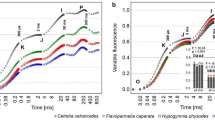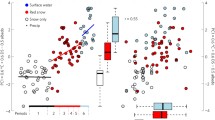Abstract
Photosynthetic activity, detected as chlorophyll a fluorescence, was measured for lichens under undisturbed snow in continental Antarctica using fibre optics. The fibre optics had been buried by winter snowfall after being put in place the previous year under snow-free conditions. The fibre optics were fixed in place using specially designed holding devices so that the fibre ends were in close proximity to selected lichens. Several temperature and PPFD (photosynthetic photon flux density) sensors were also installed in or close to the lichens. By attaching a chlorophyll a fluorometer to the previously placed fibre optics it proved possible to measure in vivo potential photosynthetic activity of continental Antarctic lichens under undisturbed snow. The snow cover proved to be a very good insulator for the mosses and lichens but, in contrast to the situation reported for the maritime Antarctic, it retained the severe cold of the winter and prevented early warming. Therefore, the lichens and mosses under snow were kept inactive at subzero temperatures for a prolonged time, even though the external ambient air temperatures would have allowed metabolic activity. The results suggest that the major activity period of the lichens was at the time of final disappearance of the snow and lasted about 10–14 days. The activation of lichens under snow by high air humidity appeared to be very variable and species specific. Xanthoria mawsonii was activated at temperatures below −10°C through absorption of water from high air humidity. Physcia dubia showed some activation at temperatures around –5°C but only became fully activated at thallus temperatures of 0°C through liquid water. Candelariella flava stayed inactive until thallus temperatures close to zero indicated that liquid water had become available. Although the snow cover represented the major water supply for the lichens, lichens only became active for a brief time at or close to the time the snow disappeared. The snow did not provide a protected environment, as reported for alpine habitats, but appeared to limit lichen activity. This provides at least one explanation for the observed negative effect of extended snow cover on lichen growth.





Similar content being viewed by others
References
Benedict JB (1990) Lichen mortality due to late-lying snow: results of a transplant study. Arct Alp Res 22:81–89
Davey MC, Pickup J, Block W (1992) Temperature variation and its biological significance in fellfield habitats on a maritime Antarctic island. Antarct Sci 4:383–388
Friedmann EI, Kappen L, Meyer MA, Nienow JA (1993) Long-term productivity in the cryptoendolithic microbial community of the Ross desert, Antarctica. Microb Ecol 25:51–69
Gannutz T (1970) Photosynthesis and respiration of plants in the Antarctic Peninsula Area. Antarct J US 5:49–52
Genty B, Briantais J-M, Baker N (1989) The relationship between the quantum yield of photosynthetic electron transport and quenching of chlorophyll fluorescence. Biochim Biophys Acta 990:87–92
Green TGA, Schroeter B, Sancho LG (1999) Plant life in Antarctica. In: Pugnaire FI, Valladares F (eds) Handbook of functional plant ecology. Dekker, New York, pp 495–543
Green TGA, Schlensog M, Sancho LG, Winkler JB, Broom FD, Schroeter B (2002) The photobiont determines the pattern of photosynthetic activity within a single lichen thallus containing cyanobacterial and green algal sectors (photosymbiodeme). Oecologia 130:191–198
Howard-Williams C, Vincent WF (1986) Ecosystem properties of Antarctic streams. NZ Antarct Rec 6:21–27
Kappen L (1989) Field measurements of carbon dioxide exchange of the Antarctic lichen Usnea sphacelata in the frozen state. Antarct Sci 1(1):31–34
Kappen L (1993) Plant activity under snow and ice, with particular reference to lichens. Arctic 46:297–302
Kappen L, Breuer M (1991) Ecological and physiological investigations in continental Antarctic cryptogams. II. Moisture relations and photosynthesis of lichens near Casey Station, Wilkes Land. Antarct Sci 3:273–278
Kappen L, Redon J (1987) Photosynthesis and water relations of three maritime Antarctic lichen species. Flora 179:215–229
Kappen L, Meyer M, Bölter M (1990) Ecological and physiological investigations in continental Antarctic cryptogams. I. Vegetation pattern and its relation to snow cover on a hill near Casey Station, Wilkes Land. Flora 184:209–220
Kappen L, Sommerkorn M, Schroeter B (1995) Carbon acquisition and water relation of lichens in polar regions—potentials and limitations. Lichenologist 27:531–545
Kappen L, Schroeter B, Green TGA, Seppelt RD (1998) Microclimatic conditions, meltwater moistening, and the distributional pattern of Buellia frigida on rock in a southern continental Antarctic habitat. Polar Biol 19:101–106
Kennedy AD (1993) Water as a limiting factor in the Antarctic terrestrial environment: a biogeographical synthesis. Arct Alp Res 25:308–315
Körner C (1999) Alpine plant life. Springer, Berlin Heidelberg New York
Lange OL (1969) Die funktionellen Anpassungen der Flechten an die ökologischen Bedingungen arider Gebiete. Ber D Bot Ges 82:3–22
Lange OL, Kilian E (1985) Reactivation of photosynthesis of dry lichen thalli through water vapor uptake from air: species specific response patterns. Flora 176:7–23
Llano GA (1965) The flora of Antarctica. In: Hatherton T (ed) Antarctica: a New Zealand Antarctic Society survey. Methuen, London, pp 331–350
Øvstedal DO, Lewis Smith RI (2001) Lichens of Antarctica and South Georgia. Cambridge University Press, Cambridge
Pomeroy J, Brun E (2001) Physical properties of snow. In: Jones HG, Pomeroy J, Walker DA, Hoham R (eds) Snow ecology: an interdisciplinary examination of snow−covered ecosystems. Cambridge University Press, Cambridge, pp 45–127
Pontaillier JY (1990) A cheap quantum sensor using gallium arsenid photodiode. Funct Ecol 4:591–596
Schlensog M, Schroeter B (2001) A new method for the accurate in situ monitoring of chlorophyll a fluorescence in lichens and bryophytes. Lichenologist 33:443–452
Schreiber U, Bilger W, Neubauer C (1994) Chlorophyll fluorescence as a nonintrusive indicator for rapid assessment of in vivo photosynthesis. In: Schulze E−D, Caldwell MM (eds) Ecophysiology of photosynthesis. Ecological studies vol 100. Springer, Berlin Heidelberg New York, pp 49–70
Schroeter B (1994) In situ photosynthetic differentiation of the green algal and the cyanobacterial photobiont in the crustose lichen Placopsis contortuplicata. Oecologia 98:212–220
Schroeter B, Scheidegger C (1995) Water relations in lichens at subzero temperatures: structural changes and carbon dioxide exchange in the lichen Umbilicaria aprina from continental Antarctica. New Phytol 131:273–285
Schroeter B, Green TGA, Seppelt RD, Kappen L (1992) Monitoring photosynthetic activity of crustose lichens using a PAM−2000 fluorescence system. Oecologia 92:457–462
Schroeter B, Green TGA, Kappen L, Seppelt RD (1994) Carbon dioxide exchange at subzero temperatures. Field measurements on Umbilicaria aprina in Antarctica. Cryptogam Bot 4:233–241
Schroeter B, Kappen L, Green TGA, Seppelt RD (1997a) Lichens and the Antarctic environment: effects of temperature and water availability on photosynthesis. In: Lyons WB, Howard-Williams C, Hawes I (eds) Ecosystem processes in Antarctic ice-free landscapes. Balkema, Rotterdam, pp 103–117
Schroeter B, Kappen L, Schulz F (1997b) Long−term measurements of microclimatic conditions in the fruticose lichen Usnea aurantiaco−atra in the maritime Antarctic. Actas del V. Simposio de Estudios Antárticos, Barcelona, pp 63–69
Schroeter B, Schulz F, Kappen L (1997c) Hydration-related spatial and temporal variation of photosynthetic activity in Antarctic lichens. In: Battaglia B, Valencia J, Walton DWH (eds) Antarctic communities. Species, structure and survival. Cambridge University Press, Cambridge, pp 221–225
Schroeter B, Sancho LG, Valladares F (1999) In situ comparison of daily photosynthetic activity patterns of saxicolous lichens and mosses in Sierra de Guadarrama, Central Spain. The Bryologist 102:623–633
Schroeter B, Kappen L, Schulz F, Sancho LG (2000) Seasonal variation in the carbon balance of lichens in the maritime Antarctic: long-term measurements of photosynthetic activity in Usnea aurantiaco−atra. In: Davison B, Howard-Williams C, Broady P (eds) Antarctic ecosystems: models for wider ecological understanding. Caxton Press, Christchurch, NZ, pp 258–262
Sommerkorn M (2000) The ability of lichens to benefit from natural CO2 enrichment under a spring snow-cover: a study with two arctic-alpine species from contrasting habitats. Bibl Lichenol 75:365–380
Winkler JB, Kappen L, Schulz F (2000) Snow as an important ecological factor for the cryptogams in the maritime Antarctic. In: Davison W, Howard-Williams C, Broady P (eds) Antarctic ecosystems: models for wider ecological understanding. Caxton Press, Christchurch, NZ, pp 220–224
Acknowledgements
SP, MS and BS thank the Deutsche Forschungsgemeinschaft for financial support (SCHR 473/4-3). LGS thanks the Spanish Ministry of Science and Technology (ANT99-0680) for financial support. Antarctica New Zealand is thanked for providing logistics both for the research in Antarctica and movements to Antarctica. The Vice-Chancellor of Waikato University is thanked for a special grant to support the work.
Author information
Authors and Affiliations
Corresponding author
Rights and permissions
About this article
Cite this article
Pannewitz, S., Schlensog, M., Green, T.G.A. et al. Are lichens active under snow in continental Antarctica?. Oecologia 135, 30–38 (2003). https://doi.org/10.1007/s00442-002-1162-7
Received:
Accepted:
Published:
Issue Date:
DOI: https://doi.org/10.1007/s00442-002-1162-7




